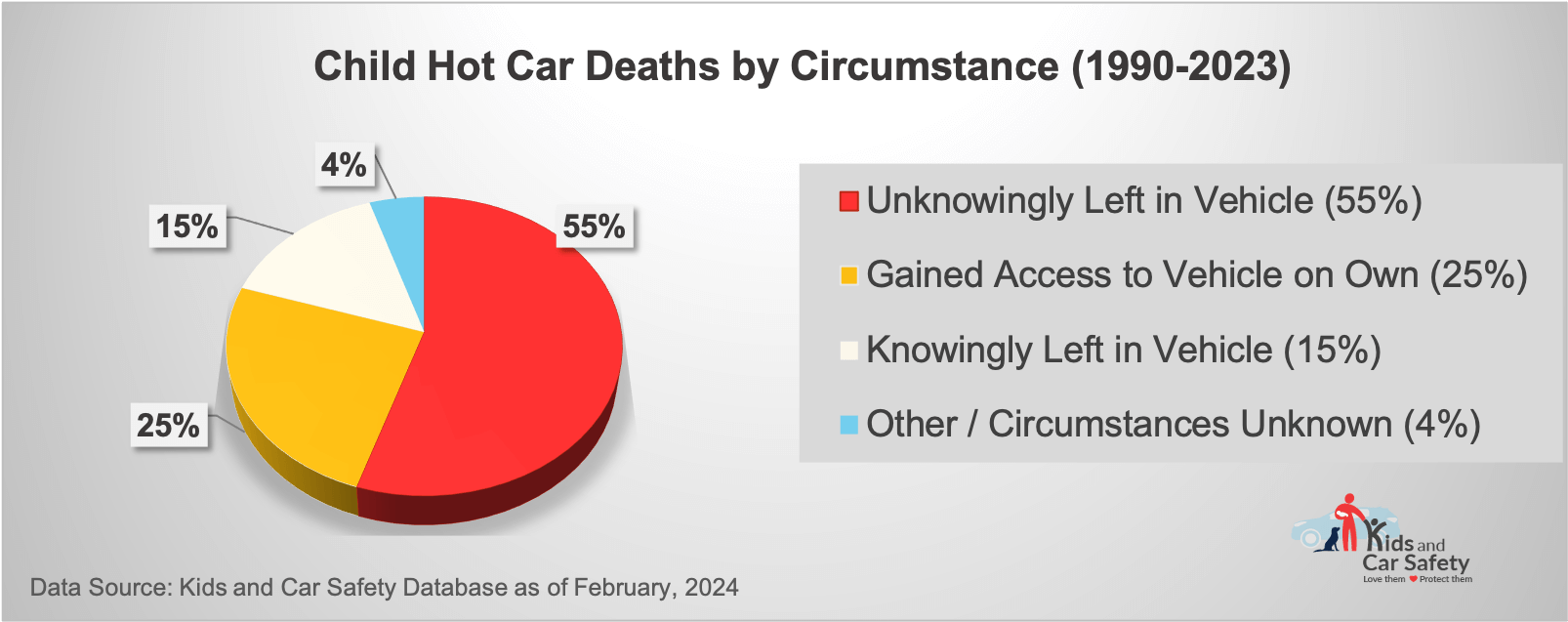Hot Car Fact Sheets
Please share these important safety tips with your childcare providers, teachers, relatives, friends, family and neighbors…It could save a life!
Downloadable pdf - English Downloadable pdf - Spanish
Downloadable pdf - Chinese Downloadable pdf - Arabic
Child hot car deaths and injuries are largely misunderstood by the general public. It can be very difficult for individuals to accept this important information about hot car dangers because people don’t think these messages apply to them.
The majority of parents and caregivers are misinformed and would like to believe that they could never “forget” their child in a vehicle. The most dangerous mistake a parent or caregiver can make is to think leaving a child alone in a vehicle could never happen to them or their family.
In over half of hot car deaths, the person responsible for the child’s death unknowingly left them in the vehicle. In most situations this happens to the most loving, caring and protective parents. It has happened to a teacher, dentist, social worker, police officer, nurse, clergyman, soldier, and even a rocket scientist. It can happen to anyone…
Statistics
The average number of U.S. child hot car deaths is 38 per year. (one every 9 days). An in-depth analysis of child hot car death data can be found here.
U.S. Child Hot Car Fatalities by Year (1990-2022)
Total: 1,085 Fatalities

| 1990 2001 |
2002 | 2003 | 2004 | 2005 | 2006 | 2007 | 2008 | 2009 | 2010 | 2011 | 2012 | 2013 | 2014 | 2015 | 2016 | 2017 | 2018 | 2019 | 2020 | 2021 | 2022 | 2023 |
| 251 | 31 | 43 | 39 | 47 | 30 | 36 | 43 | 33 | 51 | 34 | 36 | 44 | 33 | 25 | 40 | 45 | 54 | 53 | 27 | 23 | 38 | 29 |
Data Source: Kids and Car Safety (Statistics by state, county or city available upon request)
Victim Characteristics
Eighty-eight percent (88%) of children who have died in a hot car are age 3 and younger. Rear facing child safety seats do not look any different to the driver if they are occupied or empty, which can cause a parent to lose awareness of them in the back seat. Sixty-eight (68%) of children who get into vehicles on their own are male and most are age 1-4.
Circumstances
In an overwhelming majority of child hot car deaths, it was a loving, responsible parent that unknowingly left the child.
Approximately 43% of children who were unknowingly left were supposed to have been dropped off at childcare.
The Greenhouse Effect in Vehicles
- The inside of a vehicle heats up VERY quickly. Even with the windows cracked, the temperature inside a car can reach 125 degrees in minutes.
- 80% of the increase in inside temperature happens in the first 10 minutes.
- Cracking the windows does not help slow the heating process OR decrease the maximum temperature.
- Children have died from heatstroke in cars when outside temperatures were as low as 60 degrees.
Contributing Factors
- A child’s body overheats 3-5 times faster than an adult body.
- A change in daily routine, lack of sleep, stress, fatigue, and distractions are things ALL new parents experience and are just some of the reasons children have been unknowingly left alone in vehicles.
- Rear-facing car seats look the same to the driver whether there is a baby in it or not.
- Children, especially babies, often fall asleep in their rear-facing child safety seats; becoming quiet, little passengers.
Memory
Even the most loving, responsible parent can lose awareness that a child is in the vehicle with them. Dr. David Diamond, a memory specialist who has studied hot car tragedies for over a decade has two must read publications on how our memory systems can contribute to a child being unknowingly left in a hot car.
- Children dying in hot cars: a tragedy that can be prevented
- When a child dies of heatstroke after a parent or caretaker unknowingly leaves the child in a car: How does it happen and is it a crime?
Safety Tips for Parents and Caregivers
Kids and Car Safety believes the solution to these preventable tragedies is a combination of detection and alert technology in all vehicles and education. This technology is readily available and affordable and should be included in all vehicles.
Create simple habits to help keep your child safe.
Make sure your child is never left alone in a car:
- Place the child’s diaper bag or item in the front passenger seat as a visual cue that the child is with you. Or, keep a stuffed animal in the back seat. Anytime you buckle your child into the car, move that stuffy to the front with you as a visual cue that the child is with you.
- Make it a habit of opening the back door every time you park to ensure no one is left behind. To enforce this habit, place an item that you can’t start your day without in the back seat (employee badge, laptop, phone, handbag, etc.)
- Ask your childcare provider to call you right away if your child hasn’t arrived as scheduled.
- Clearly announce and confirm who is getting each child out of the vehicle. Miscommunication can lead to thinking someone else removed the child.
Make sure children cannot get into a parked car:
- Keep vehicles locked at all times, especially in the garage or driveway. Ask neighbors and visitors to do the same.
- Never leave car keys within reach of children.
- Use childproofing knob covers and door alarms to prevent children from exiting your home unnoticed.
- Teach children to honk the horn or turn on hazard lights if they become stuck inside a car.
- If a child is missing, immediately check the inside, floorboards and trunk of all vehicles in the area carefully, even if they’re locked.
Additional safety tips:
- Never leave children alone in or around cars; not even for a minute.
- If you see a child alone in a vehicle, get involved. Call 911 immediately. If the child seems hot or sick, get them out of the vehicle as quickly as possible.
- Be especially careful during busy times, schedule changes and periods of crisis or holidays. This is when many tragedies occur.
- Use drive-thru services when available (restaurant, bank, pharmacy, dry cleaner) and pay for gas at the pump.


